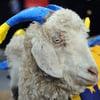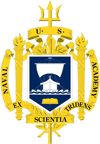
In the course of many USNA Notable Graduates’ careers, many have accomplished great things because they have been faced with insurmountable odds, adversity that could topple the hardiest of souls, and choices that have no upside, no matter how they’re considered. For USNA Notable Graduate Captain Thomas Jerome Hudner, Jr., his career was defined by making an impossible choice.
A Career Hastened by War
Thomas Jerome Hudner, Jr. was the oldest of five children born to Thomas Hudner and his wife in the manufacturing town of Fall River, Massachusetts. As was family tradition, he attended high school at Phillips Academy in Andover, Massachusetts. He had planned to attend Harvard when an appointment to the United States Naval Academy changed his life’s trajectory. Hudner graduated in 1946 with a group that included USNA Notable Graduates President Jimmy Carter and Vice Admiral James Stockdale. Their class is still considered the Class of 1947 but graduated a year earlier due to the U.S. efforts to support WWII.
Hudner served on USS Helena and then went to Pearl Harbor, Hawaii. In 1948, he was ordered to start flight training in Quonset Point, Rhode Island. One year later, he had earned his wings, and when the U.S. joined the Korean War in 1950, Hudner’s squadron went. They were directed to support the ground troops during the Battle of the Chosin Reservoir, which spanned from November through December 1950 and played a key role in thwarting the Chinese efforts to expel the United Nations from North Korea.
A Man Down
Then came the moment that changed everything. On December 4, 1950, Hudner was engaged in a dangerous mission with his six-plane squadron, helping provide air support to the Marines trapped by Chinese forces. He was wingman to his good friend Ensign Jesse Brown. Their squadron was flying about fifteen miles behind enemy lines among the 6,000-foot mountains when Brown’s F4U-4 Corsair was shot down and he crashed. The remaining five planes circled his position and were amazed to see Brown had opened his canopy and was trying to get down. But the trouble was just beginning. There was smoke coming from the plane and Hudner knew that could signal the catastrophic start of a raging fire.
Fateful Decision
He had mere moments to decide what to do. Without seeking permission from his superiors, Hudner skillfully placed his F4U-4 Corsair close to Brown’s with a wheels-up landing. It was 15 degrees out and there was snow everywhere. After wading about 50 feet through waist-deep snow, Hudner realized that Brown’s leg was crushed and he was stuck in the plane’s crushed fuselage. He was bleeding and struggling with the extreme temperatures, and the angle and build of the plane made him nearly impossible to reach. They were also deep in enemy territory and in grave danger of being captured at any moment.
Brown dipped in and out of consciousness as Hudner radioed for help. The Navy would send a rescue helicopter, but it wouldn’t arrive for 30 minutes. So Hudner did the best he could to save his friend, using his bare hands to pack snow around the flames ripping through the engine and threatening to destroy the plane. After thirty minutes, Pilot Marine Lieutenant Charlie Ward arrived in his Sikorsky rescue helicopter with an ax and fire extinguisher that Hudner had requested, and the two men worked to free Brown. As Brown slipped into and out of consciousness they were unable to tell whether he was still alive.
The work was exceedingly difficult in the extreme cold. The extinguisher wasn’t putting out the flames and the ax only bounced off the plane’s exterior. Then Ward pulled Hudner aside and told him that the helicopter could not travel at night. Its unreliable brakes were not going to hold on the icy slope where it had been precariously parked, and the darkness would be there soon. He gave Hudner the impossible decision: he could leave on the helicopter or stay with Brown overnight. Hudner and Brown were good friends and most importantly, wingmen. Hudner was devastated by the decision. He knew that he could not save Brown, and he knew that by staying he would most assuredly die of exposure or be captured by the Chinese forces. He was also suffering from his own injuries from the crash landing. He went with Ward, yelling to Brown, “We’ll be back for you.”
When he returned to USS Leyte, Hudner begged for a mission to retrieve Brown, but it was too dangerous. A few days later, several Corsairs flew over the site with napalm, destroying the two planes and giving Brown “a warrior funeral.”
Medal of Honor Recipient
Hudner thought he would be court-martialed for intentionally crashing his plane without orders, but instead, he received the Medal of Honor, an award that was bestowed upon him by President Harry S. Truman on April 13, 1951. He was the first in the Korean War to become a Medal of Honor Recipient. Captain Hudner went on to another 22 years in the Navy and completed 27 combat missions in Korea as well as serving in the Vietnam War as the executive officer of USS Kitty Hawk. In 1973, he retired from the Navy.
After his retirement from the Navy, Captain Hudner worked as a management consultant and then as Massachusetts’ Department of Veterans’ Services commissioner from 1991 to 1999. His and Brown’s incredible story became a biography called Devotion: An Epic Story of Heroism, Friendship, and Sacrifice. Written by Adam Makos, it was published in 2014 and adapted as a movie in 2022. As part of this project, Makos also helped Hudner organize a trip to the site of the accident to help retrieve Brown’s remains. Unfortunately, the weather precluded their attempt. Hudner had made heroic efforts to make good on the promise he made to Brown so many years before to go back for him. In 2017, Hudner was able to celebrate the christening of the naval destroyer USS Thomas Hudner. Then, just months later, he passed away on November 13, 2017, in Concord, Massachusetts.
Naval Academy Stories
Captain Hudner’s story is one of heroism, devotion, and enduring bravery in the face of the toughest challenges. Hudner, like all of our USNA Notable Graduates, is an inspiration and a constant guiding light here at the Naval Academy, embodying what it means to be a great naval officer. We are proud to share his story, and we are grateful for his selfless service.
Come see where Captain Hudner’s story began at the Naval Academy, where women and men in uniform are following in his very footsteps. Be a part of the history that happens here every day. Your trip gives back to the Brigade, as your USNA tours, dining, and shopping provide funds for the midshipmen's extracurricular activities like cultural arts, music, theater, and club sports. Visit today, and be inspired by the Naval Academy’s amazing stories.






